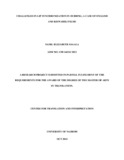| dc.description.abstract | The principal objective of this project is to examine the strategies dubber translators use in
achieving lip synchrony. We have narrowed to cases where short loops and long loops exist in an
audio visual translation. We have considered the Jesus Film and its translation to English.
The main purpose of the study was to find out the words dubber translators use as fillers in a case
of short loop and those omitted in a case of long loops with purpose of achieving lip synchrony.
Chapter One, is an introductory chapter that focuses on the background of the study, statement of
the problem, hypothesis, significance of the study, scope and limitation, theoretical framework,
literature review and methodology.
Chapter two, deals with the fillers in short loops. It is in the introduction of this chapter that the
term „short loops‟ has been defined and the examples of words used as fillers-in the Jesus film-
discussed.
Chapter Three, looks at overcoming long loops, to achieve lip synchrony, by using omission.
Words that have been omitted in the Jesus film have been discussed in this chapter. There is also
an exposition of the forms of omission.
Chapter Four, looks at the data collection. Data has been collected from interviews carried out on
dubber translators who expounded on the process of dubbing.
Chapter Five, is focused on the findings of our research in challenges of lip synchronization in
dubbing, conclusion and we also give our recommendations. | en_US |

